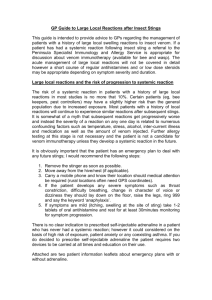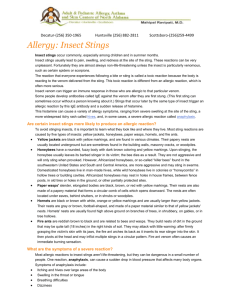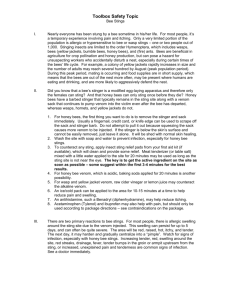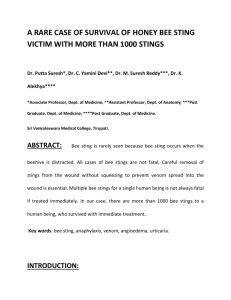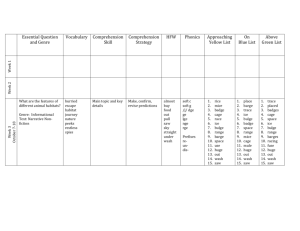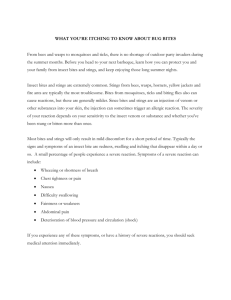Ohio State University Extension Fact Sheet Entomology 1991 Kenny
advertisement
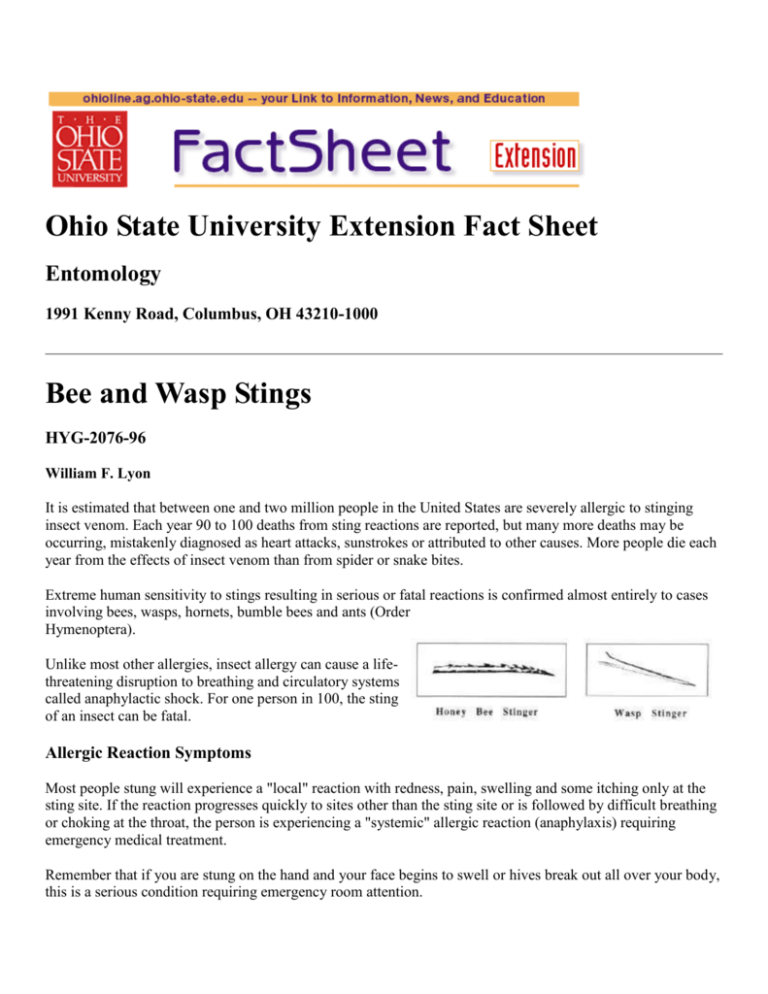
Ohio State University Extension Fact Sheet Entomology 1991 Kenny Road, Columbus, OH 43210-1000 Bee and Wasp Stings HYG-2076-96 William F. Lyon It is estimated that between one and two million people in the United States are severely allergic to stinging insect venom. Each year 90 to 100 deaths from sting reactions are reported, but many more deaths may be occurring, mistakenly diagnosed as heart attacks, sunstrokes or attributed to other causes. More people die each year from the effects of insect venom than from spider or snake bites. Extreme human sensitivity to stings resulting in serious or fatal reactions is confirmed almost entirely to cases involving bees, wasps, hornets, bumble bees and ants (Order Hymenoptera). Unlike most other allergies, insect allergy can cause a lifethreatening disruption to breathing and circulatory systems called anaphylactic shock. For one person in 100, the sting of an insect can be fatal. Allergic Reaction Symptoms Most people stung will experience a "local" reaction with redness, pain, swelling and some itching only at the sting site. If the reaction progresses quickly to sites other than the sting site or is followed by difficult breathing or choking at the throat, the person is experiencing a "systemic" allergic reaction (anaphylaxis) requiring emergency medical treatment. Remember that if you are stung on the hand and your face begins to swell or hives break out all over your body, this is a serious condition requiring emergency room attention. Normal Reaction:--Lasts a few hours. Sting site is painful, reddened, may swell and itch, but will quickly dissipate. Large Local Reaction:--Lasts for days. Sting site is more painful, swelling and itching may be present both at the sting site and in surrounding areas. Severe Allergic Reaction:--Can commence rapidly (in a few minutes) after the sting occurs. The whole body is involved. Person may feel dizzy (lightheaded), nauseated and weak. There may be stomach cramps and diarrhea. There can be itching around the eyes, a warm feeling or coughing, hives breaking out, followed with vomiting and swelling. There can be wheezing, difficult breathing (shortness of breath) or swallowing, hoarse speech, drop in blood pressure, shock, unconsciousness and darkened skin following. Reactions may occur in a few minutes with most deaths within 30 minutes, but some within 15 minutes and some in five minutes or less. Systemic Sensitivity Doctors believe that once systemic sensitivity occurs, it almost always increases in severity with each following sting (varies in individual persons). The more quickly symptoms appear after the sting, the more severe the reaction. (Some beekeepers can no longer keep honey bees after several years due to severe allergic reactions developing). The problem occurs when some individuals produce excessive quantities of antibodies in their immune system. The excess antibody production usually follows the initial sting to which there is no reaction. However, when the person is stung again, the insect venom entering the body combines with the antibody, produced by the first sting, which triggers a series of internal reactions, resulting in severe allergic symptoms. Stings Whenever stung, try to capture or know the identity of the insect to help doctors diagnose the trouble. When a bee or wasp stings, it injects a venomous fluid under the skin. Honey bees have a barbed stinger. Only the honey bee leaves her stinger (with its venom sac attached) in the skin of its victim. Since it takes two to three minutes for the venom sac to inject all its venom, instant removal of the stinger and sac usually reduces harmful effects. Scrape away with a sideways movement (one quick scrape) with a fingernail. Never try to use the thumb and forefinger or tweezers to pinch out the stinger since this maneuver forces (injects) more venom from the sac down into the wound. Wasps, yellowjackets and hornets have a lance-like stinger without barbs and can sting repeatedly. They should be brushed off the victim's skin promptly with deliberate movements, then quietly and immediately leave the area. Sting Prevention Persons, especially allergic to stings, should practice certain simple precautions to avoid being stung. Outdoors Spray the patio, picnic and garbage areas with permethrin (Astro, Dragnet, Flee, Permanone, Prelude, Torpedo) or pyrethrins (Kicker, Microcare, Pyrenone, Pyrethrum, Synerol). Some formulations are restricted use. A licensed pesticide applicator or pest control operator can apply restricted use pesticides such as bendiocarb + pyrethrins (Ficam Plus), bifenthrin (Biflex), cyfluthrin (Tempo), cypermethrin (Cynoff, Cyper-Active, Demon, Vikor), deltamethrin (Suspend) and tralomethrin (Saga). Other labelled pesticides include acephate (Orthene), amorphous silica gel (Drione), bendiocarb (Ficam), carbaryl (Sevin), chlorpyrifos (Dursban, Empire, Tenure), diazinon, propoxur (Baygon) and resmethrin (Vectrin). If you destroy the nests (aerial and ground) yourself, use a commercially available stinging insect control aerosol containing Baygon, pyrethrin, permethrin or resmethrin which can shoot a high-volume spray stream 15 to 20 feet, giving excellent quick knockdown and kill of wasps and bees hit. After dark or in the evening, most have returned from foraging to the nest. Thoroughly saturate the nest with spray, contacting as many insects as possible. Do not stand directly under an overhead nest, since some insects receiving some of the spray may fall but retain their ability to sting for some time. Repeat treatment if reinfestation occurs. Again, it is always best, if allergic, to hire a professional exterminator to remove a nest. Never try to burn or flood a nest with water since this practice will only make these stinging insects angry and aggressive. When eating outdoors, keep food covered until eaten, especially ripe fruit and soft drinks. Any scent of food, such as outdoor cooking, eating, feeding pets or garbage cans, will attract many bees and wasps (especially yellowjackets). Keep refuse in tightly sealed containers. Dispose of refuse frequently (two times per week or more) during late summer and early autumn when most activity occurs. Be careful not to mow over a nest in the ground nor disturb a nest in a tree or eaves of the home. Any disturbance often will infuriate and provoke stinging. Should a bee or wasp fly near you, slowly raise your arms to protect your face and stand still or move slowly away through bushes or indoors to escape. Never move rapidly, which often provokes attack. Never strike or swing at a wasp or bee against your body since it may be trapped causing it to sting. If crushed, it could incite nearby yellowjackets into a frenzied attack. The wasp venom contains a chemical "alarm pheromone," released into the air, signaling guard wasps to come and sting whomever and whatever gets in their way. If a bee or wasp gets into a moving car, remain calm. The insect wants out of the vehicle as much as you want it out. They usually fly against windows in the car and almost never sting the occupants. Slowly and safely pull over off the road, open the window and allow the bee or wasp to escape. Unfortunately, many serious accidents have resulted when the driver strikes or swings at the insect during operation of the vehicle. A small insecticide aerosol can for control of stinging insects, kept in the car away from children and pets, can be used in an emergency. Pick fruits as soon as they ripen. Pick up and dispose of any fallen fruit rotting on the ground. Keep lawns free of clover and dandelions, which attract honey bees. Avoid close contact with flowering trees, shrubs and flowers when bees and wasps are collecting nectar. Vines, which may conceal nests, should be removed from the house, if practical. Individuals Since perfume, hair spray, hair tonic, suntan lotion, aftershave lotions, heavy-scented shampoos, soaps and many other cosmetics attract insects, they should be avoided. Avoid shiny buckles and jewelry. Wear a hat and closed shoes (not sandals). Don't wear bright, colored, loose-fitting clothing, which may attract and trap insects. Flowery prints and black especially attract insects. To avoid stings, the beekeeper wears light-colored (white) clothing, preferably cotton (never wool). Beginning beekeepers use bee gloves, a head veil, long sleeves and coveralls with the pant legs tucked into boots or tied at the ankles to prevent unnecessary multiple stings. A bee smoker is always used before opening up an established hive. To avoid stings, stay away from any bee hives for an hour or more (depending on weather) after the beekeeper has gone. Bees are more angry on cloudy, dark rainy days in early spring of the year. Hypersensitive persons should never be alone when hiking, boating, swimming, golfing, fishing or involved outdoors since help is likely needed in starting prompt emergency treatment measures if stung. It is wise for the person to carry a card or to have an identification bracelet or necklace, such as "Medic Alert," identifying the person as hypersensitive to an insect sting. It will alert others to the condition in an emergency when sudden shock-like (anaphylactic) symptoms or unconsciousness (fainting) occurs after one or more stings. Medic Alert tags can be purchased at Medic Alert Foundation, 2323 Colorado Avenue, Turlock, California 95380, (Telephone: 1-800-922-3320). Normal Reaction Sting Treatment For stings causing itch, irritation, redness and swelling at the sting site, the following may be useful: Ice Baking Soda Meat Tenderizer--for people not allergic to bee stings. Use any brand with Papain. Make a paste with a few drops of water to a teaspoon of meat tenderizer and quickly apply to the sting to reduce pain and inflammation (breaks down components of sting fluid). Ammonia Solution--Apply a 1 to 2.5 percent solution no more than three to four times daily. Oral Antihistamines--Tablets may be chewed for faster relief, but liquids are more readily absorbed after oral ingestion (Chlortrimeton, Dimetane, Teldrin). Epinephrine Inhaler (Bronkaid mist, Primatene, Medihaler-Epi) Topical Steroids (Cortaid, Dermolate, Lanacort, etc.) Local Anesthetics (Benzocaine, Americaine, Dermoplast, Bactine, Foille, Lanacaine, Solarcaine) Oral Steroids--Prescription only. These medicines can be located in a tackle box, in camping gear, in the car and in the home. Store at room temperature away from room lighting or sunlight. Emergency Kits for Insect Stings Highly-sensitive persons should have two emergency kits prescribed for them by their physician within easy access at all times. One kit should be carried at all times and the other kept in the family car. It is best to store kits in a cool, dry place (refrigeration) with easy access. The kit contains one sterile syringe of Epinephrine (adrenalin) EPIPEN, ready for injection, four chewable, yellow tablets of Chlortrimeton (antihistamine), two sterile alcohol swabs for cleaning the injection site and one tourniquet. Inject the syringe into the thigh (subcutaneously) under the skin as soon as the first sting symptoms show. A tourniquet placed above the sting site, when on an arm or leg just tight enough to obstruct blood return but not so tight as to stop circulation, will help until medical treatment is obtained. Loosen the tourniquet every 10 minutes. Other kits include ANA Emergency Insect Sting Kit and Insect Sting Kit available by prescription only at the drugstore or pharmacy. Hypersensitivity Testing and Desensitization Program Diagnostic skin testing with insect venom(s) is recommended for those who have experienced immediate systemic reaction to an insect sting. About half of adult patients will react similarly or worse to another sting unless desensitized with a series of appropriate venom injections. The percentage of serious reactions to another sting is less with children, but may still occur. Immunotherapy is given about every four weeks, indefinitely, unless skin tests indicate the patient is no longer sensitive. Freeze-dried venom from honey bee, yellowjacket, baldfaced hornet, etc. is available. They are believed to be 98 to 99 percent effective. |

